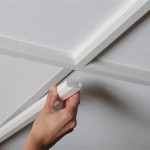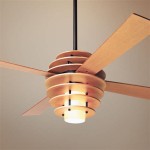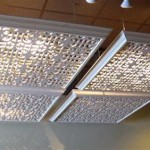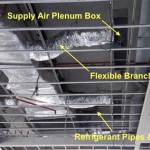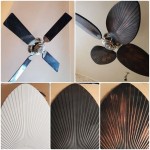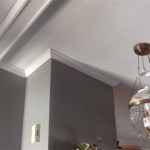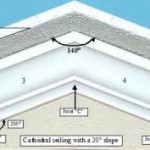What is a Non-Suspended Ceiling System?
A non-suspended ceiling system, also known as a direct-attach ceiling, is a type of ceiling construction where the ceiling panels or tiles are directly attached to the structural support above without any intermediary suspension system. This method eliminates the need for a separate grid or framework commonly seen in suspended ceilings. Instead, the panels are directly secured to the joists, beams, or other overhead structures, creating a seamless and flush surface.
Key Features and Benefits of Non-Suspended Ceilings
Non-suspended ceiling systems offer several advantages over their suspended counterparts, making them a popular choice for various projects. These benefits include:
1. Cost-Effectiveness
One of the most significant benefits of non-suspended ceilings is their lower cost compared to suspended systems. The absence of a suspension grid and the simpler installation process significantly reduce material and labor costs. This makes them an economically viable option, particularly for large-scale projects or when budget constraints are a concern.
2. Ease of Installation
The direct attachment method simplifies installation, as it eliminates the need for complex grid configurations. The panels can be easily secured to the structural support using adhesives, screws, or other appropriate fasteners. This streamlined installation process translates to faster project completion and reduced labor hours.
3. Enhanced Aesthetics
Non-suspended ceilings offer a clean and streamlined aesthetic, as they create a smooth, uninterrupted surface. The absence of a visible grid enhances the visual appeal of the space, making it ideal for applications where a minimalist design is desired. Additionally, the direct attachment method allows for a greater variety of panel materials and finishes, providing greater flexibility in achieving the desired aesthetic.
4. Improved Sound Absorption
Non-suspended ceilings can be designed to provide better sound absorption than suspended systems. The direct attachment to the structural support minimizes the transmission of sound vibrations. Additionally, the use of sound-absorbing materials in the ceiling panels can further enhance the acoustic performance of the space, making it ideal for areas where noise reduction is essential, such as offices, classrooms, and recording studios.
Applications of Non-Suspended Ceilings
Non-suspended ceilings find diverse applications in both residential and commercial projects. They are commonly used in situations where cost-effectiveness, ease of installation, and aesthetic appeal are paramount. Some typical applications include:
- Residential Projects: Non-suspended ceilings are often chosen for bedrooms, bathrooms, living rooms, and kitchens. They offer a cost-effective solution for creating a clean and modern look while maintaining a comfortable and functional space.
- Commercial Projects: Non-suspended ceilings are widely used in offices, retail spaces, restaurants, and healthcare facilities. Their ability to create a professional and modern atmosphere, combined with their ease of maintenance, makes them a popular choice for these commercial environments.
- Industrial Applications: In industrial settings, non-suspended ceilings can be utilized in workshops, factories, and warehouses. Their durability and resistance to moisture and dust make them suitable for harsh environments.
Types of Non-Suspended Ceiling Systems
Non-suspended ceiling systems come in various types, each with its unique characteristics and applications. Some common variations include:
- Drywall Ceilings: These systems involve attaching drywall panels directly to the structural support using adhesive or screws. Drywall ceilings offer a durable and versatile option, allowing for different finishes and textures.
- Tile Ceilings: Tile ceilings utilize pre-fabricated ceiling tiles that are directly attached to the structural support using adhesives or a grid system. They offer a variety of material options, including acoustic tiles, metal tiles, and mineral fiber tiles.
- Integrated Ceiling Systems: These systems combine the ceiling with other building elements, such as lighting fixtures and HVAC systems. The integrated system provides a streamlined and aesthetically pleasing solution, while also maximizing efficiency and reducing clutter.
Conclusion
Non-suspended ceiling systems offer a range of advantages, including cost-effectiveness, ease of installation, enhanced aesthetics, and improved sound absorption. Their versatility makes them suitable for various applications, from residential homes to commercial spaces and industrial settings. Understanding the different types and features of non-suspended ceiling systems is crucial for making an informed decision for your project.

Non Perforated Metal Lay In False Ceiling System China Suspended Made Com

Typical Ceiling Configuration Not Showing Seismic Bracing Based On Scientific Diagram

Experimental And Numerical Assessment Of Suspended Ceiling Joints Bulletin Earthquake Engineering

Suspended Ceiling Grid Frame System Please Choose Color Quantity Tiles Not Included

Beam Decorative Non Structural Ceiling System By Asi Architectural Arco

T Grid Ffu Ceiling System For Cleanroom Lamp Non Walkable China Made In Com

Section 5 Installation

10m2 White Suspended Ceiling Grid System Kit X28 Tiles Not Included X29

Seismic Steel Stud Ceiling Solutions Siniat

Access Panel For Suspended Grid Ceilings 5000 Series Profab
Related Posts

